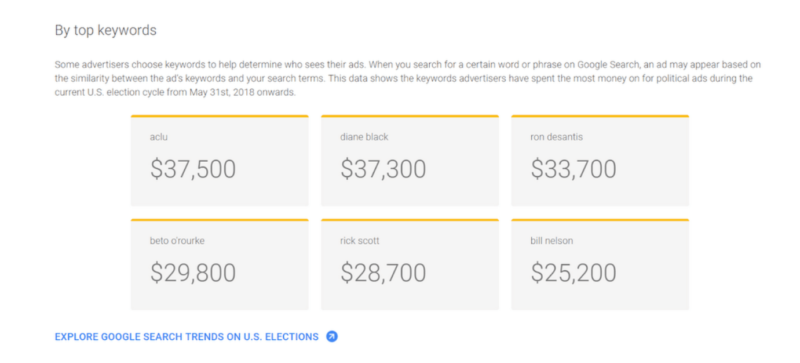
Google is building more transparency into the political ads and advertisers running campaigns on its ad networks. After updating its political ad policies in May — enforcing new ID requirements for anyone purchasing political ads — the company is now sharing its first transparency report focusing solely on political ads, as well as a political ad library.
Google first announced it would be releasing a public political ad transparency report and library of political ads that have been verified three months ago, and made them available Wednesday.
Google’s political ad transparency report
The political ad transparency report includes a breakdown of money spent on political ads by state and by Congressional district and a list of the top political advertisers based on how much they are spending on Google ad campaigns.
Google political advertising transparency report: Ad spend by state
There is also a table highlighting the most popular keywords used by political advertisers, based on ad spend for each keyword or phrase.
“This data shows the keywords advertisers have spent the most money on for political ads during the current U.S. election cycle from May 31st, 2018 onwards,” writes Michee Smith, the product lead for Google transparency reports.
Google political advertising transparency report: Keywords

Google says the report data will be updated weekly leading up to the US midterm elections in November and can be downloaded.
Google’s political ad library
The political ad library is a searchable archive of political ads appearing on Google’s ad networks going back to May 31, 2018. Queries can be filtered to find ads that ran during a specific date range, the amount spent on the ad’s campaign, impressions or the type of ad (image, video, text).
Search results can be sorted as well by “most recently launched,” “spend – high to low” or “impressions – high to low.”
Google political ad library

Clicking on an ad in the search results will display the full ad, and if it’s a video ad, you can view it. You’ll be able to see the advertiser that paid for the ad, the ad type, the amount spent on the ad, the number of impressions it received and the date range it ran.
In addition to offering an archive of political ads going back to May 31, Google has made the information available on Google Cloud BigQuery so that anyone can write code to run unique queries on its political ad data.
“Researchers, political watchdog groups and private citizens can use our data set to develop charts, graphs, tables or other visualizations of political advertising on Google Ads services,” writes Smith.
Currently, the political ad transparency report and ad library are exclusive to the US, but Google says it is aiming to expand its efforts:
“We’re working with experts in the U.S. and around the world to explore tools that capture a wider range of political ads — including ads about political issues (beyond just candidate ads), state and local election ads, and political ads in other countries.”
Online safety measures aimed at political ads and advertisers
Transparency and safety are top of mind for Google and other digital ad platforms when it comes to political advertisers and campaigns. Almost all major social platforms have updated their ad policies after the discovery that Russian forces interfered in the 2016 US elections by pumping malicious ad content into Facebook and Twitter (and to a lesser degree, Google).
Twitter has made a number of moves to improve the health of its platform, from introducing profile labels for political candidates to a massive purge of locked accounts on the platform. Facebook has also been under the gun to make its platform safer during the upcoming elections. In addition to drastically cutting back on the amount of user data available to apps, Facebook also updated its ad policies.
Also, like Google, both Facebook and Twitter launched searchable ad archives. Twitter’s Ad Transparency Center shows all ads (not just political ads) shown in past seven days. Facebook’s ad archive includes political and issue ad content going back seven years.
